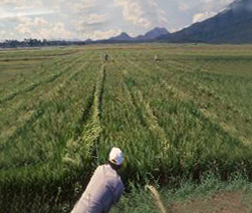Hybrid rice
What is a hybrid?
 Rope (above) or sticks are often used to increase the spread of pollen in hybrid seed production fields.
Rope (above) or sticks are often used to increase the spread of pollen in hybrid seed production fields.A hybrid is the product of a cross between two genetically distinct rice parents. When the right parents are selected, the hybrid will have both greater vigor and yield than either of the parents.
The advantages of hybrid rice are:
- Increased yields,
- Increased vigor (which makes them more competitive with weeds), and
- Increased resistance to diseases and insects.
The disadvantages of hybrid rice are:
- Seed is expensive and;
- Farmers cannot use their seed from one year to another.
To produce hybrids, you need:
- A national seed production and distribution system,
- A national quality assurance program, and
- National experts to oversee production of lines and seed.
Note: Despite early concerns, there are now hybrids with good grain quality.
How do you develop hybrid seed?
To produce hybrid seed, you need:
- A male sterile line – a rice variety without viable pollen. It is referred to as the female and accepts pollen from the male parent to produce the hybrid seed
- A male (pollen) parent – a rice variety with normal reproduction function. It is referred to as the male parent to provide pollen for the female parent in the same fields.
Major hybrid seed management consideration includes:
- Synchronization of flowering – Both parents need to flower at the same time. Therefore, planting dates of the two parents will often have to vary.
- Supplemental pollination – To help the spread of pollen ropes or sticks are often used to improve the spread of pollen from the male to the female line.
- Giberellic acid (GA) application – GA increases the emergence of the female panicles from the sheath – improving the ability of the female to accept pollen from the male.
Developed with input from: SS Virmani, Fangming Xie, and MA Bell